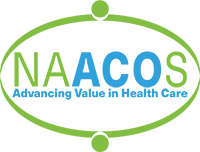|
June 25, 2018 Ms. Seema Verma Re: (CMS-1694-P) Request for Information on Promoting Interoperability and Electronic Health Care Information Exchange through Possible Revisions to the CMS Patient Health and Safety Requirements for Hospitals and Other Medicare-and Medicaid-Participating Providers and Suppliers Dear Administrator Verma: The National Association of ACOs (NAACOS) appreciates the opportunity to submit comments on the request for information on ways to further promote interoperability and electronic healthcare information exchange. NAACOS is the largest association of ACOs, representing more than 5 million beneficiary lives through more than 300 Medicare Shared Savings Program (MSSP), Next Generation, and commercial ACOs. The ACO model is only successful if providers are able to share patient health information in ways that can allow practitioners to better coordinate the care provided to its patients. Today there remain obstacles to obtaining this critical information. For value-based care models like ACOs, the ability to succeed to their fullest potential is not possible without providing clinicians with the information they need to provide effective transitions of care between hospitals and community providers. We applaud the Administration’s leadership and efforts to increase sharing of information to create better opportunities for care coordination. We agree that while both adoption of Electronic Health Records (EHRs) and electronic exchange of information have grown substantially among hospitals, significant obstacles to exchanging electronic health information across the continuum of care persist and, in some cases, routine electronic transfer of information post-discharge has not been achieved by providers and suppliers in many localities and regions throughout the nation. For this reason, the ACO may not have access to complete information about all of the clinical information and services that are provided to its assigned beneficiaries by providers outside the ACO, creating a significant challenge to the ACO’s care coordination efforts. A critical factor in an ACO’s success at providing high quality care while lowering costs is the sharing of data across the ACO’s providers and care settings. This often requires the ACO to gather information from payers, health systems, labs, pharmacies and other sources but still may leave the ACO without a complete picture. Our comments below reflect ACOs’ desire to make patient health information fully transparent and available to the entire care delivery team. Should CMS adopt standards requiring hospitals to release Admissions, Discharge and Transfer (ADT) data? ACOs aim to provide coordinated care to ensure that patients get the right care at the right time and avoid unnecessary duplication of services. In order to provide highly coordinated care, ACOs need critical information about a patient’s admission to and discharge from a hospital. NAACOS recommends that Emergency Department (ED) visit and admission information, as well as transfer and discharge information is shared at a minimum as a requirement of CMS health and safety standards for providers and suppliers participating in the Medicare and Medicaid programs (the Conditions of Participation (CoPs), Conditions for Coverage (CfCs), and Requirements for Participation in Medicare. Specifically, we recommend the following:
1. CMS should adopt the following standards requiring hospitals to release ADT data:
2. CMS should allow hospitals to meet these conditions over time (for example, by phasing in notification for greater numbers of patients over time) using existing health information exchange networks, private sector partners, or direct connections to community practitioners. Such an approach gives hospitals and community practitioners time to develop the processes and infrastructure necessary to meet such a requirement. Existing community networks are preferred where available.
3. CMS should require hospitals to make certain information electronically available to patients within 24 hours, such as discharge instructions and a summary of care, including through a designated third-party tool of their choice if desired. Providing this admission, discharge and transfer information makes much-needed structured data about a patient’s health transparent to the entire care delivery team and allows care teams to monitor patients’ health and connect with them proactively. Informing providers about key encounters like hospitalizations and emergency department visits allows the care team to follow-up with discharge instructions and ensure a more effective transition of care. Taking this unprecedented step will allow for ACOs to more effectively monitor the health of the patients they serve and we fully support these changes. Are there any other operational or legal considerations (for example, HIPAA), obstacles, or barriers that hospitals and other providers and suppliers would face in implementing changes to meet new or revised interoperability and health information exchange requirements? The Health Insurance Portability and Accountability Act (HIPAA) Privacy, Security, and Breach Notification Rules were designed to protect the privacy and security of patient health information. The HIPAA rules are flexible and scalable to accommodate the broad range in types and sizes of entities that must comply with them. This means that there is no single standardized program that could appropriately train employees of all entities. Due to this complexity, there is currently a large amount of misinformation and misunderstanding around these requirements and what the law truly allows in terms of sharing patient information. Therefore, we recommend that the Department of Health and Human Services (DHHS) conduct a broad education campaign to increase understanding regarding HIPAA and what this law currently allows for sharing of patient health information for treatment, payment and health care operations. Providing clear and concise education to the provider community would eliminate confusion that currently may act as a barrier to sharing of patient health information for treatment purposes while providing clinicians and health care teams with greater confidence in their ability to share certain health information. In conclusion, we support the Administration’s commitment to increasing interoperability and are pleased to see this unprecedented movement to allow more sharing of information in the best interest of patients. Effective population health management requires transparent data across all inpatient and outpatient episodes of care. Making these changes will provide ACOs with the ability to more effectively coordinate patient care. We look forward to a continued dialogue on this topic. Sincerely,
Allison Brennan |

